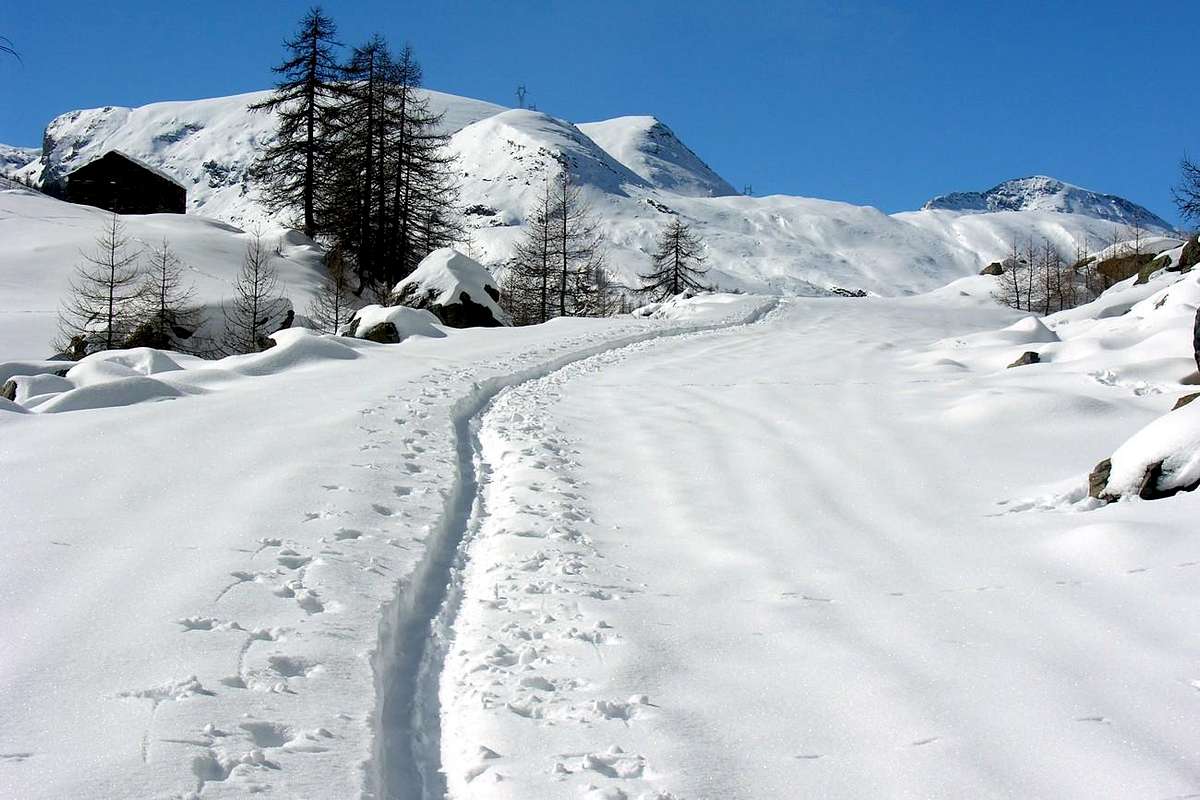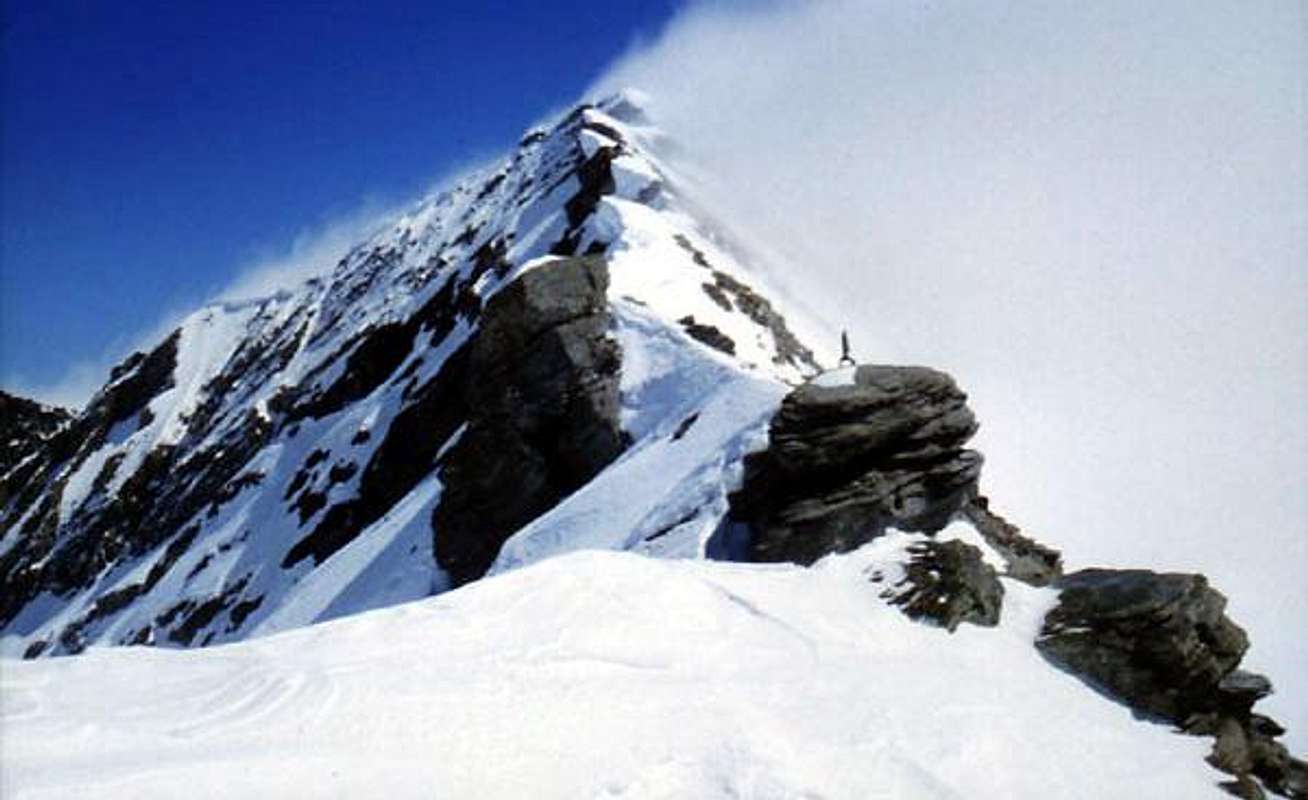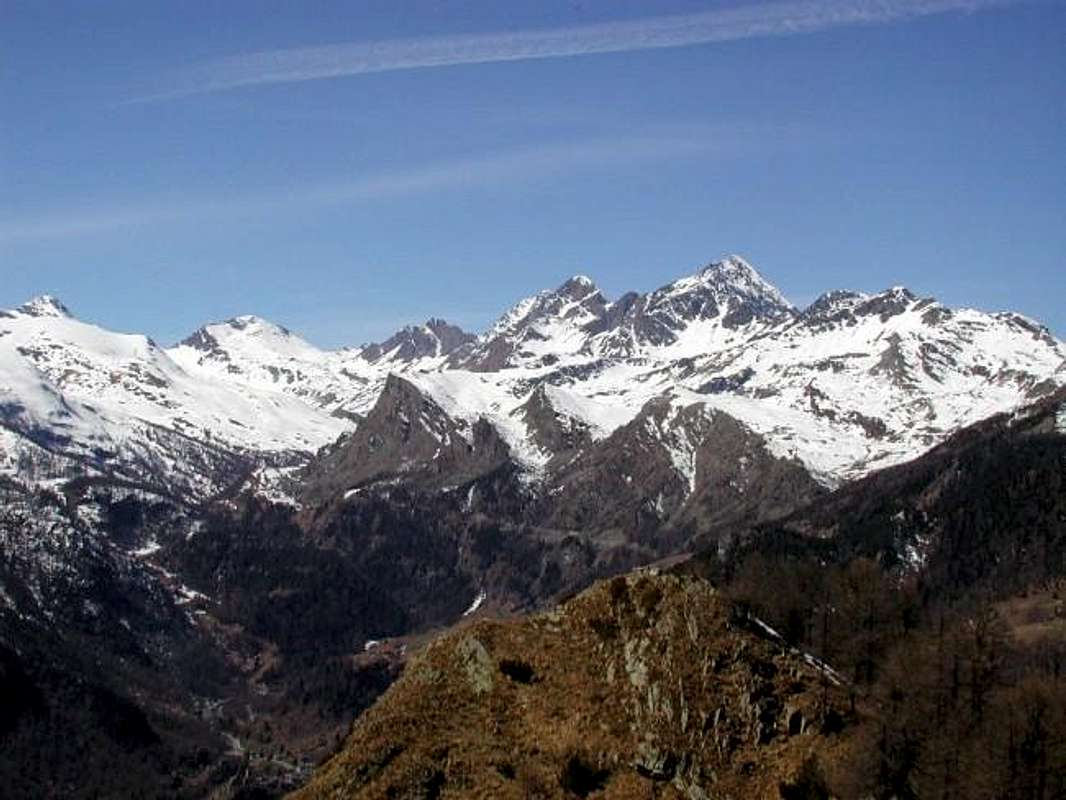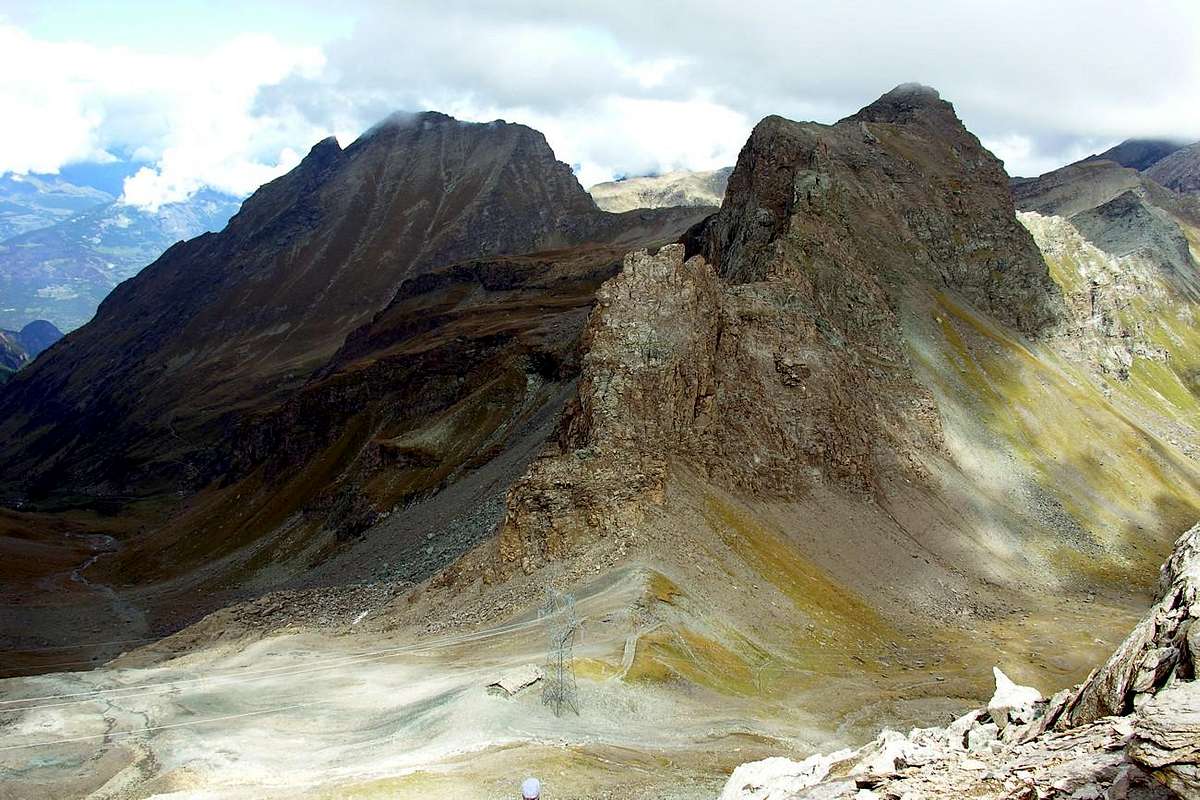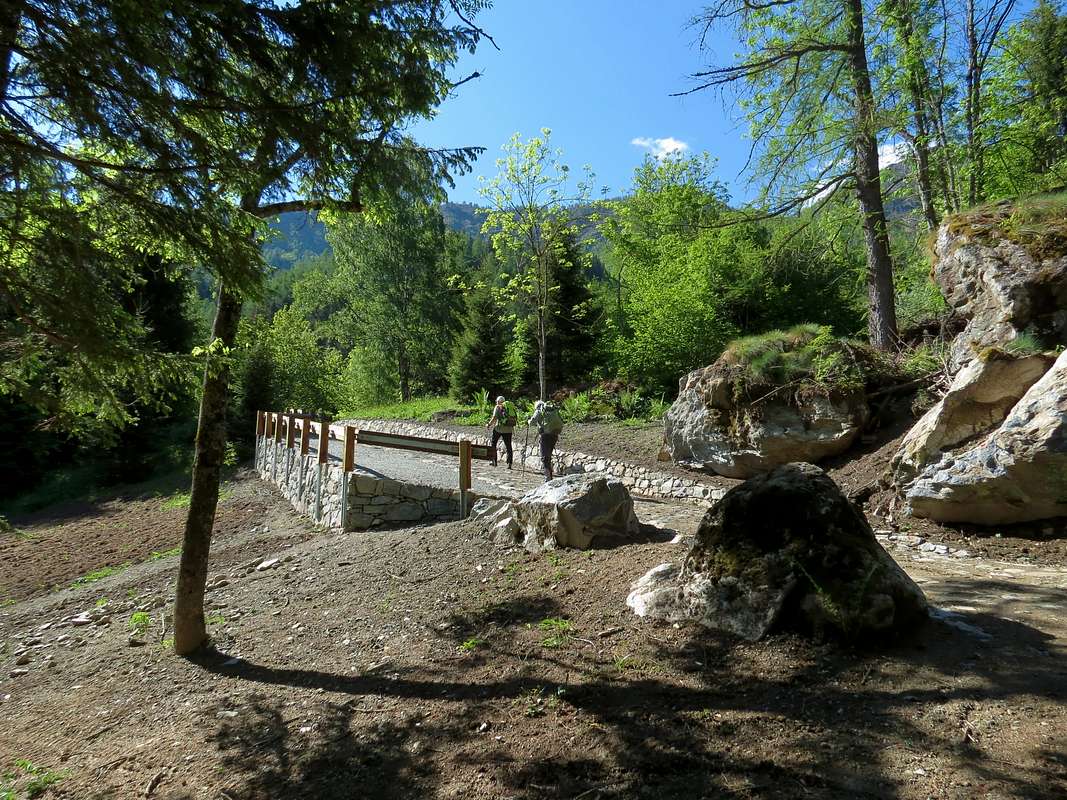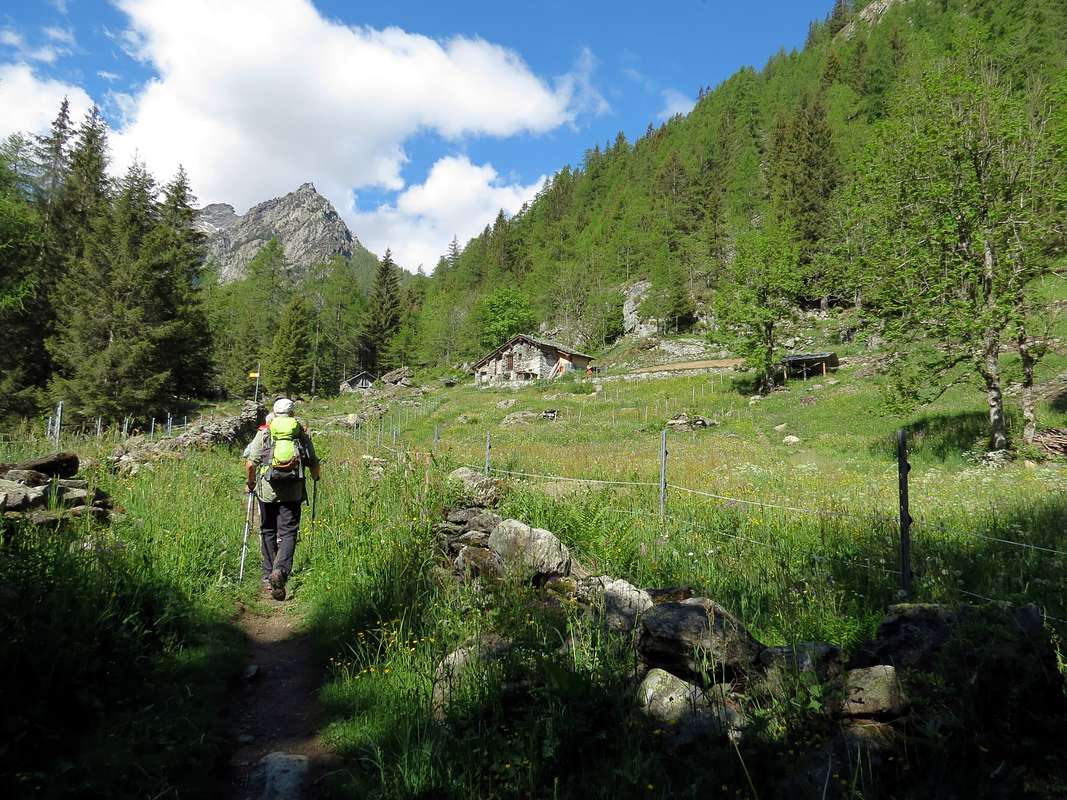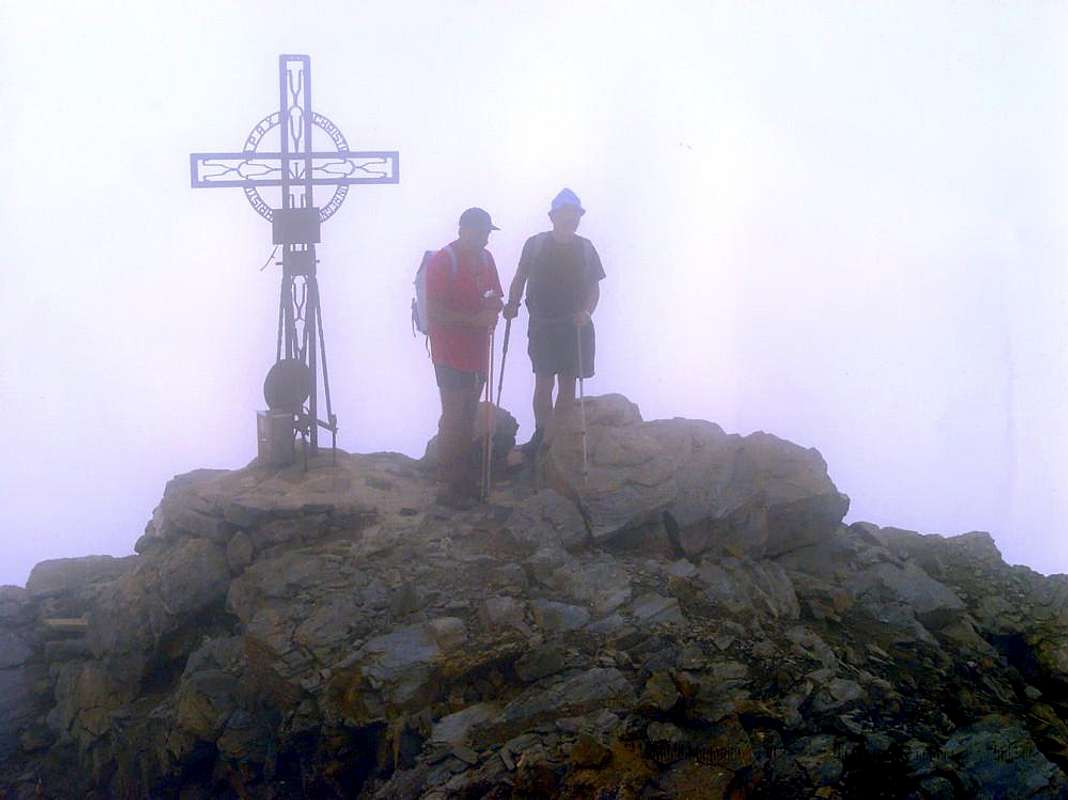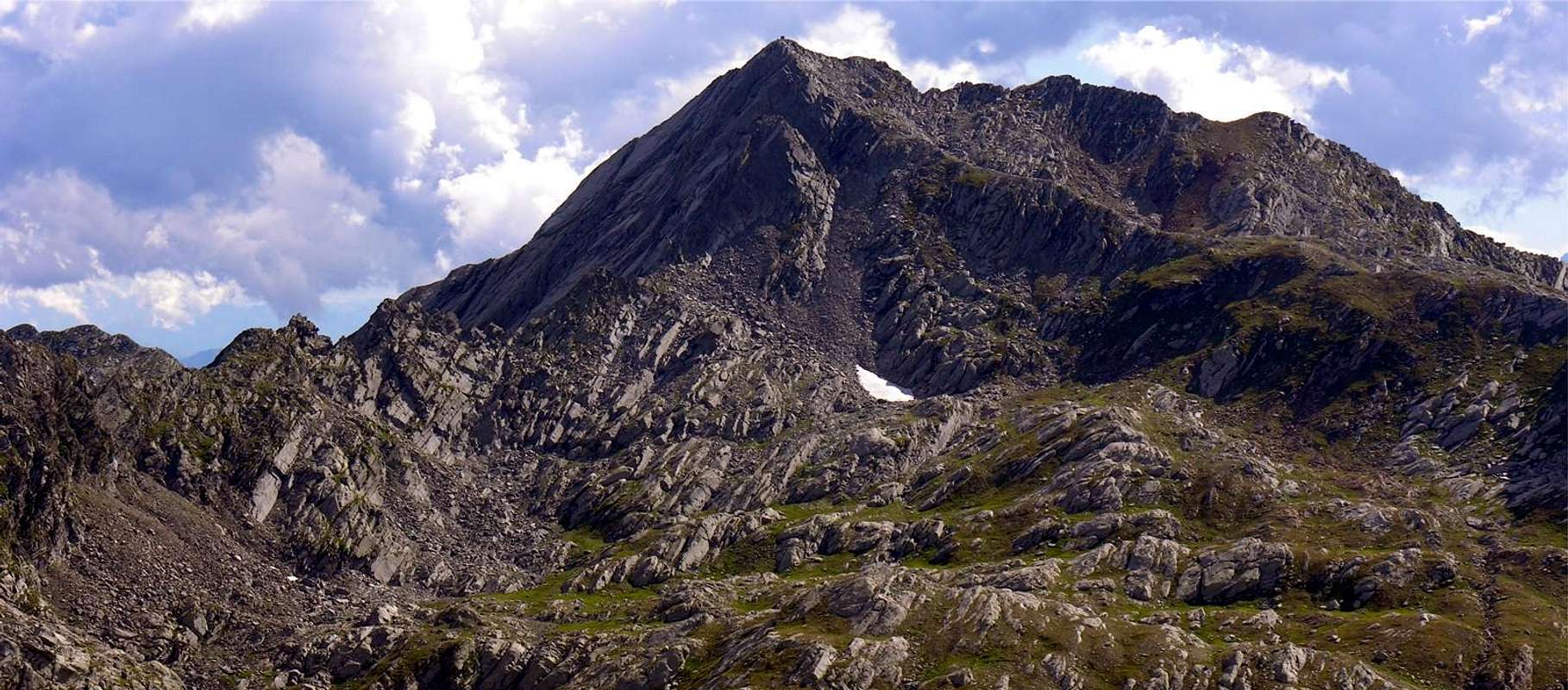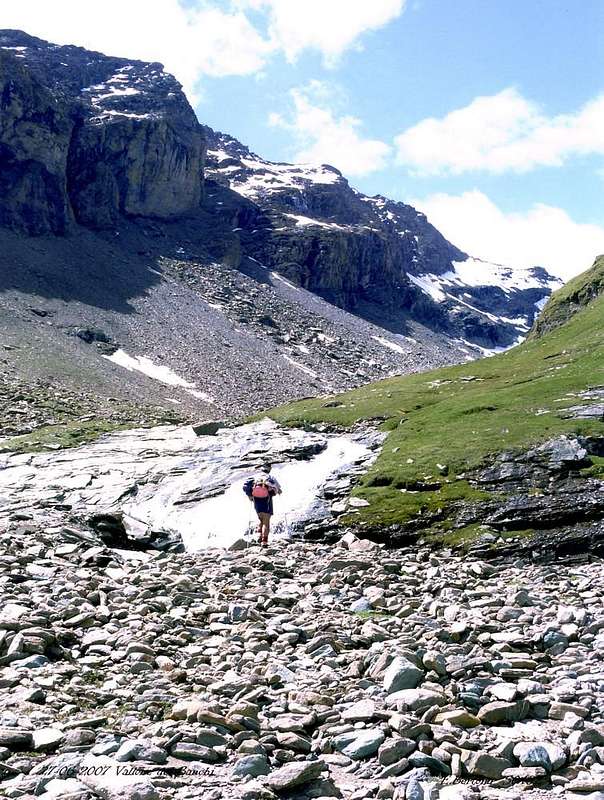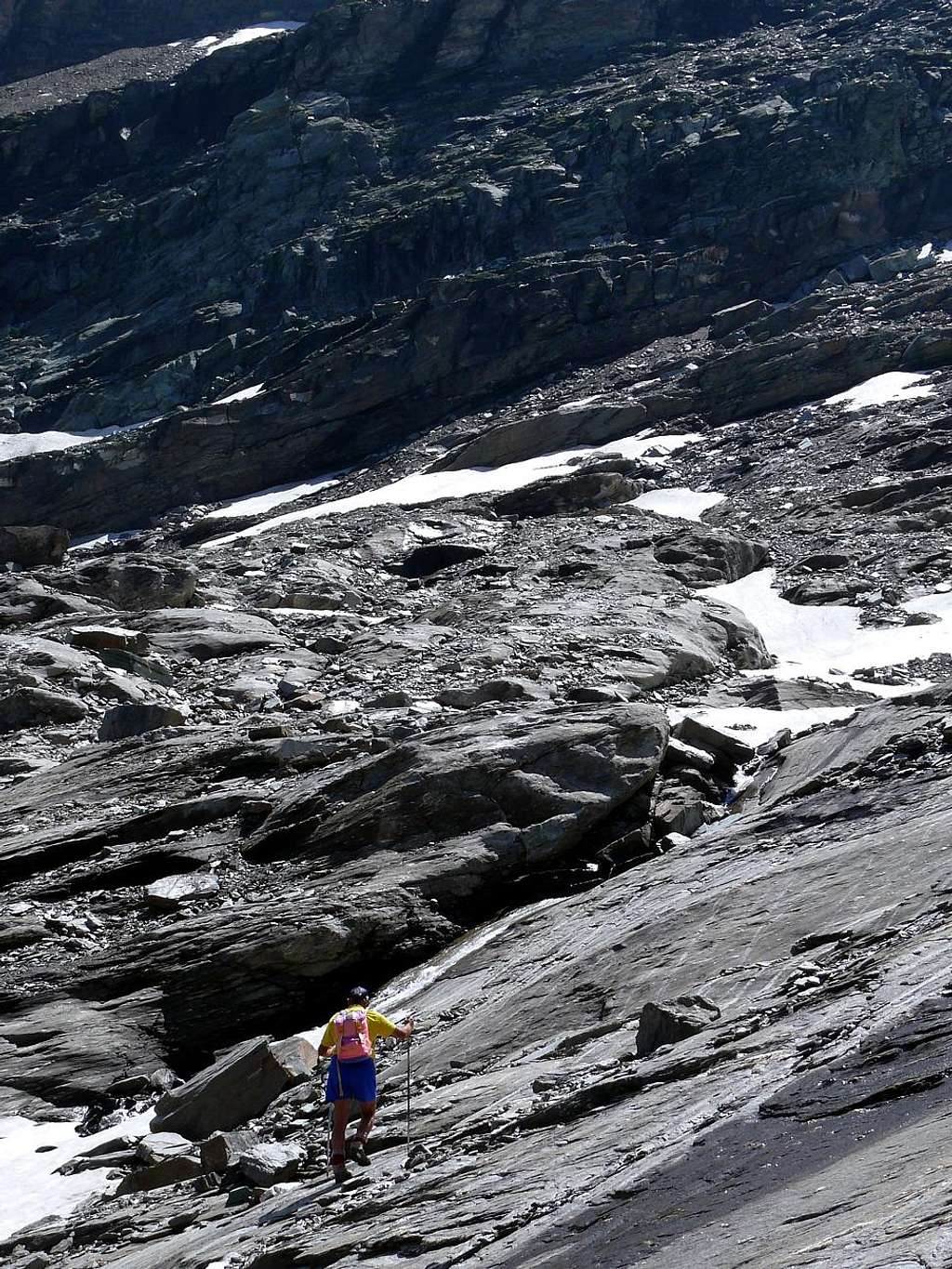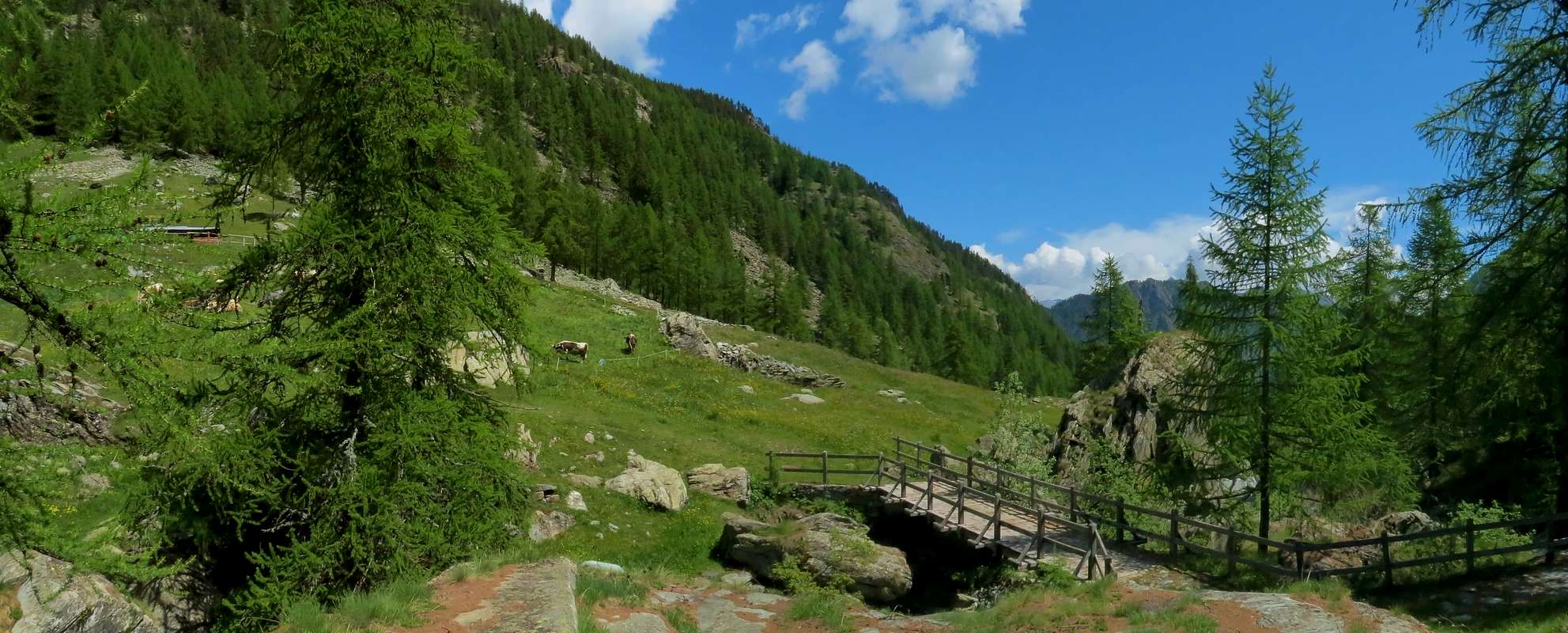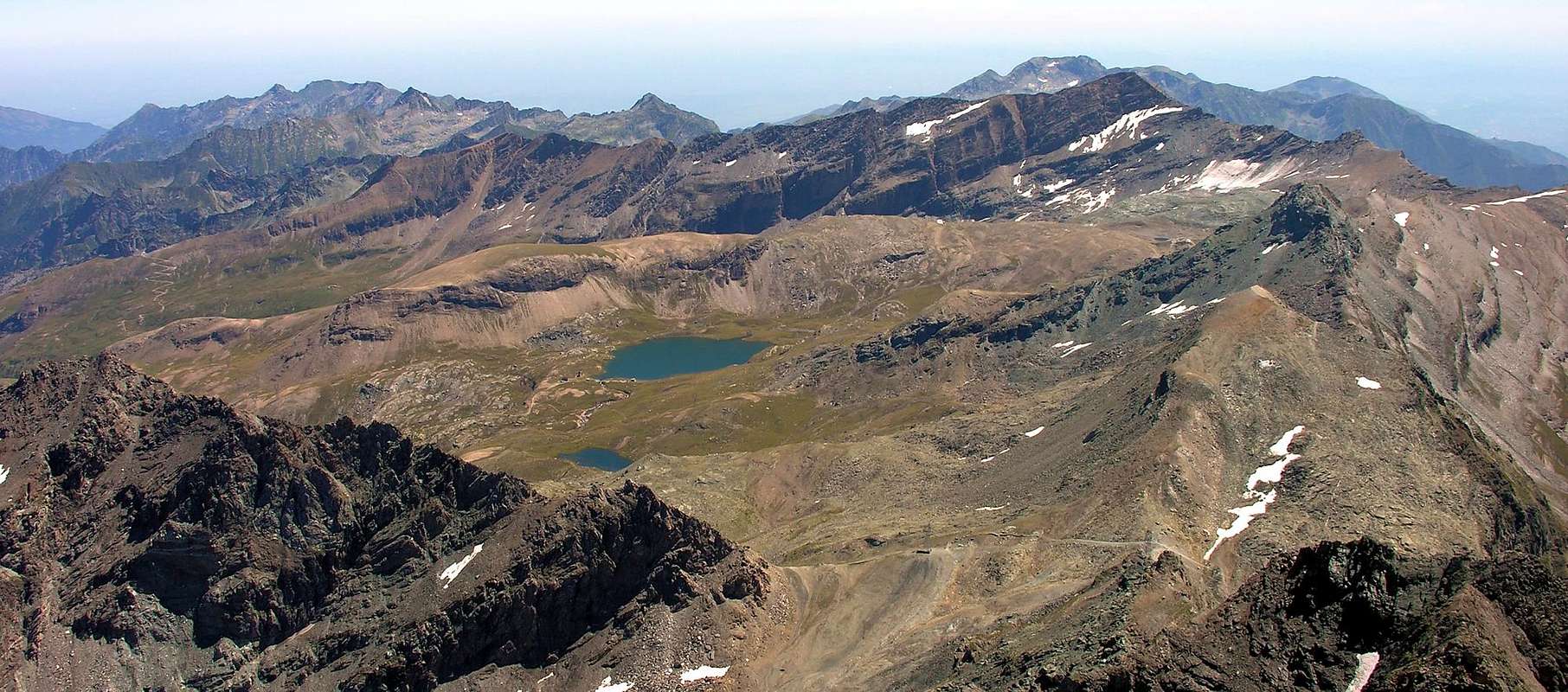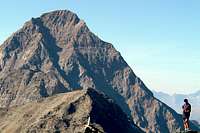bIn tutta la Valle di Champorcher esiston due soli rifugi, ma la stessa ne può utilizzare quattro. I due, propri di questo territorio, son quelli di Dondena, appena a monte dello omonimo Villaggio, e quello del Miserin presso il Lago e Santuario con lo stesso nome. Ma altri due, vista la vicinanza, permettono d'accedere al Vallone dei Laghi sopra Champdepraz con il Rifugio Barbustel presso il Lago Bianco ed al Vallone di Urtier con il Rifugio "Sogno di Berdzé" (Sogno del Pastore) presso l'Alpe di Peradzà, appena al di sotto della Finestra di Champorcher. Il primo si raggiunge, entrando nel Parco Naturale del Monte Avic,scavalcando il Colle del Lago Bianco e con una breve discesa, il secondo permette un facile collegamento sia con il Miserino che con Dondena. Entrambi sono molto utilizzati dagli Escursionisti per i loro trekkings o semplicemente per piccole traversate. Inoltre é possibile raggiungere il nuovo Rifugio Borroz del Rotary nell'Alta comba Tersiva, ma qui le distanze aumentano notevolmente. Tutti i valloni del circondario possiedono un notevole numero di alpeggi considerando che la pastorizia é molto diffusa sia con mucche che con pecore e capre, ma é bene qui ricordare che i medesimi sono privati e per la maggior parte chiusi anche in inverno. Sono ammesse esclusivamente le emergenze e non certamente l'utilizzo comune, poiché i medesimi appartengono a proprietà private. Anche i Santuari, come quello di Santa Anna a Settentrione o di Re Tempio a Sudest, permettono la visita, ma non il ricovero. Per contro le zone frequentate sono alquanto limitate già con la bella stagione, vista la lunghezza degli avvicinamenti, mentre d'inverno il bianco della neve ed i grandi silenzi padroneggiano l'intera vallata. Tranne che nella zona del Larìs presso la Gran Cimetta dalla quale si senton provenir "squilli" di gioia degli sciatori e sulla Strada Reale che porta a Dondena, dove si pratica lo Sci-Alpinismo e van di moda le Racchette da neve. Per il resto qui domina solo Lui, Nonno Inverno, che nella cattiva stagione qui si ripara adagiando le sue coltri bianche tra la Rosa dei Banchi ed il Mont Glacier, in attesa di vedere arrivare dalla Pianura del Po il Vento della Primavera, che tornerà a tingere nuovamente l'intera valle d'un verde smagliante.
All its Vallons
VALLEYS & VALLONS In order to deploy clockwise from the Low Valley (Bard & Pont-Bozet Commons) towards Champorcher & Dondena Hamlets.
Champorcher Valley & surroundings Southern Side Brenva (e) Vallon (Pont Bozet): from Pont Bozet
(775m), Crest Village, Fontana Alp
(1.291m) to
- 1) - la Cavanna (1.644m), Celleras Alp (1.976m) Vallera (2.377m) in Southeast, Dondogna (2.389m) and Valbella (2.550m) in Southwest Passes, with paths-traces. From Fontana to Mialet (1.544m) and Grand Lavassey Alps
- 2) - Lavere Pass (2.203m), without path; from Creton, Grand Derby (1.747m) Pastures to
- 3) - Eastern Corni (2.546m) Pass, with path and traces in final part. From Barmé Alp (1.923m) to
- 4) - Fricolla (2.542m) Pass, path and traces, and
- 5) - Brouillet (2.450m) Pass, without.
Manda Vallon (Pont Bozet):
- 1) - from Pont Bozet, Cotetta/Barmafumo, Verney (1.298m), la Frete, Low, Upper Bozet (1.573m) Hamlets; from these in Southeast to
- 2) - Secco, Nero (1.940m) and Champas Lochs, with paths. From Nero in Southeast, Lavere Pond to
- 3) - Lavere Pass, without. From Champas, nearby Alp, in South to
- 4) - Cornuto (2.412m) Lake, near Forest Rangers Cabine and Brouillet Pass, Fricolla Pass and Point (2.676m), traces on short crest. From Bataille in South Chanton, La Manda (2.003m) Alpages to
- 5) - Chenessy (2.383m) Lake, with traces;
- 6) - in North-northwest Mount Digny (2.145m), small path. From Mont Digny to Southwest
- 7) - Mont Giavin (2.431m), through path-traces on small easy crest.
Legna Vallon:
- 1) - from Outre l'E(y)ve, Porte Alp (1.344m), Montaz Pasture (1.497m), Ourty Alp (1.507m), alternative to Sant'Antoine (1.831m), Chenessy Pastures (2.051m), Peroisa Alp (2.184m) Alp, Chilett Alp (2.351m) and Lake (2.324m); in South
- 2) - Orti Pass (2.524m), with path-traces. In Southwest
- 3) - Santanel Pass (2.463m) to Santanel Lake, with path, respectively to Chiusella Valley-Pianprato Valleys in Piedmont.
Vercoche Vallon:
- 1) - from Ourty, Vercoche Alps (1.879m), Lake (2.202m), Laris Hill (2.581m), paths; to
- 2) - Pic Molère (2.638m), by crest.
Laris Vallon: from Chardonney (1.455m) in South Pian di Greus, Prarion Alp (1.796m), fork Low Prarion, Low and Upper Laris Alpages (1.950m) after in Southeast Larissa Loch (2.489m) and Hill (2.581m). From this:
- 1) - Bec or Pic Mol(l)ère by easy Southwest Crest or
- 2) - to ake Reale (2.449m) in Piedmont, with paths. Alternative: from Dondena (2.097m), Shelter (2.200m), Cimetta Rossa (2.466m) to Larissa Loch, by dirt road.
Banchi Vallon:
- from Dondena in South, Shelter, Pian di Roche Alp (2.238m), with path, Rosa Pass (2.957m), through morainic traces Rosa Glacier.
Miserin Vallon: from Dondena, Shelter, to Miserin Refuge, Sanctuary, Lake (2.578m), through dirt road. From thys
- 1) - in East Mount Rasciàs (2.784m), with traces,
- 2) - in South Rosa Pass, small path and traces,
- 3) - in Sout-soutwest Balma Pass (2.941m), traces;
- 4) - in West Cima di Peradzà (3.021m) or Saddle 2.946 meters, between Peradzà and Bec Costazza (3.092m), by traces on morainic slopes and easy debris crests. Western Side Fenêtre de Champorcher Vallon: from Dondena, Shelter, fork 2.526 meters, between Blanc (2.527m) and Noir (2.551m) Lochs, with dirt road, fork 2.592 meters to Fenetre Pass (2.826m) and descent to Sogno di Berdzé Refuge (2.531m), near Peradzà Alp, in Urtier Walloon, with paths.
Pontonnet Vallon: from Dondena in West, fork 2.526 meters, Pontonnet Lake (2.702m), Fénis Hill (2.857m), Pontonnet Hill (2.897m), with paths. Northern Side Glacier Vallon: from Dondena in West-northwest, bridge 2.334 meters up Ayasse Torrent to fork 2.800 meters and in Northeast small saddle before Lago Gelato (2.824m); from this
- 1) - in Northwest Col Fussì (2.912m), with paths and descent to Upper Comba Tersiva-Clavalité-Fénis Vallon.
- 2) - In Northeast Great Shoulder (3.003m) and Mount Glacier (3.186m), with path, traces and easy rocks on crest of final part.
Gias(s)et Vallon: from Dondena, in Northeast Giaset Alp (2.155m) and Loch (2.308m), with path; from this in North Gran Rossa Pass (2.766m) to Gran Lago, through traces. In East path to Giaset Hill (about 2.400m) and
- 1) - Western Bec Raty (2.417m), by traces or Lake (2.283m), with path.
Raty Vallon: from parking about 1.800 meters on Dondena's Royal Road, alternative 1.920 meters around, Sapy Alp (1.979m), Raty Lake (2.283m), with path. From thys
- 1) - in North Gran Rossa (2.866m); in Northeast Bocon Damon (2.792m), both through traces and easy rocks in terminal crests.
Vernouille-Muffé Vallons: from Champorcher-Château (1.427m), Arbussey, Mont Blanc, La Cort Villages, la Grand Cort Alp (1.944m):
- 1) - in Northwest Alp and Lake Vernouille (2.145m), with path, to Tête des Hommes (2.614m), through moraine and easy rocks; in North Alp and Lake Muffé (2.019m), Lake Bianco or Croix Hills to Barbustel Refuge in Champdepraz Walloon, with paths.
- 2) - from the last hill in East Cima Piana (2.512m), by path under West Crest;
- 3) - in Southeast Cima Piana Hill (around 2.300m), with path. From Lake Muffé in East Cima Perche (2.396m), with path.
Terra Rossa Vallon: from la Grand Cort in East Terra Rossa Hill (2.075m) and from la Cort Arcomy Hill, Point (1.952m, 1.991m), paths. Others small more to the Northeast: from Mellier (1.293m), Petit Rosier (1.444m) Hamlets to Possoneil or Possoueil Hill (1.842m), with path; from Petit and Grand Rosier (1.452m) Villages or from la Place (1.020m) to Santa Anna Oratory (1.706m), near Plan Fenêtre Hill (1.775m), with paths.
40 and more Walks Excursions & Climbings recommended
The Vallons most important and the recommended Walks Excursions Climbings (15) Southern Side: Brenve, Manda, Legna, Vercoche, Monte Nero, Larìs, Bantses & Miserin Vallons
1) - Gorge of the Ratus
(about 930m): Walk from Pont-Bozet, crossing the bridge avove Ayasse Torrent, with path in South-southeast to Brenve Torrent (
T; 0h'30).
2) - Re Tempio Chapel (1.474m): Excursion with path before in South-southeast to Crest di Sotto (1.061m; Lower) Pastures; after to the Southeast, crossing Echellier Bois (Wood) and Brenve Torrent towards Larsine Pasture (about 1.380m). Finally through very tight switchbacks on the trail at the terminal part (E/F; 2h'15/2h'30).
3/3bis) - "Five Lochs Tour" into the Manda (z) or Amanda vallon (2.176m) or to Punta di Chenessy (2.630m): Excursion before with path in Southwest to Bozet di Sopra (1.573m; Upper) Alpage and following fork about 1.600 meters; after in Southesat crossing the forest to the entrance in a small walloon, between Bec Chaty and Grand Bec, always with path to Lago Secco or Lac Sec (1.750m; Dry) immediately under the Betasson Alp (1.833m), Lago Nero (1.943m; Black); after with short return to previous small fork and with path to the West Lac de Champas just before the homonym Alp (1.928m, 1.967m). From this last, without path and along the torrent towards the two ramification of the same:
a) - in Southwest to Chenessy Lake (2.384m), below Chenessy Ridge and Point
b) - In Southeast to Cornuto or Cornouy Lake (2.413m), near Forest Rangers Bivouac and below Punta della Fricolla (EE/F; 4h'00/4h'45). Also
3bis) - Climbing from Mandaz Alp (2.004m) (*** reached from Champas Lake and Alp with crossing from previous routes or directly in walloon floor passing Bozet (1.759m) and Chanton (1.859m) Pastures) by enough easy East-northeast Face and North Crest in final to Punta di Chenessy also towards Manda Pass (about 2.385/90 meters) and by North-northeast Crest in terminal part (two enough exposed steps) (EE/A/F+/PD-; 2h'15/2h'30)
4) - Fricolla Pass or Col de l'Alleigne (2.550m; "Tours of Three Vallons"): Excursion pathless and through traces into the moraines in South from Cornouy Lake to Brouillet Pass (2.450m); after through a brief descent with traces in adiacent Brenve Vallon above Alp Breuil (2.090m). Finally by Eastern Slope, with traces, to pass with. Moreover possibility of descent in Legna's Vallon towards Chenessy and Peroisa Alps, Case Nuove Sant' Antonio Pastures and Outre l'Eve Village (EE/F; 3h'45/4h'15).
5) - Mont Digny (2.145m): Excursion from Pont-Bozet/Delivret Village with path to Bozet di Sopra
(1.573m); after in Northwest by path in East Slope (
E/F; 2h'45/3h'00).
6) - Outre l'Eve
(1.299m) to Punta di Vòrea
(2.554m): Excursion-Climbing with path before in South-southwest to Ourthy
(1.507m) Pastures, after in South to Saint Antoine Case Nuove (
1.833m; New Homes). From this three possibilities:
a) - along a small torrent between steep moraines in West towards Vorea Carving (around 2.455/60 meters) and by North-northeast Crest with steps from II° to III° (Normal Via; A/PD/PD+/AD-; 3h'45/4h'5 Outre l'Eve 0h'30 from carving). Or
b) - through less steep moraines in Southwest at the base of East-northeast Spur with climbing (steps from I°+ to II°/II°+/III°-) on edge of the ridge (A/PD/PD+/AD/AD+; 2h'15/2h'45). Also,
c) - continue from Sant'Antonio Case Nuove to Peroisa Alp (2.184m); leaving left the path to Chiletto Lake go in a small and narrow vallon reaching the South-southwester Ridge at a typical pinnacle shaped cannon. With te same, climbing enough easy on the thread, to Summit (A/F+; 2h'15/2h'45 Peroisa; better route for the descent).
7/8) - Outre l'Eve towards Chilétt or Vercoche Lochs: Excursion with path in Southwest towards Ourthy (1.507m) Alp; from the following fork
a) - in South to Legna's Vallon up to the Lac de Chilet (létt) or Chiletto (2.394m; EE/F; 2h'45/3h'15), below Santanel Hill and Monte Nero. In Southwest to
b) - in Southwest to Vercoche or Vercoce Walloon up to the two homonym Lakes (2.202m, 2.215m) and overhanging Mulère small Loch (2.316m), below Pointe Vòrea and Ridge (2.394m; EE/F; 2h'30/3h'00).
9) - Lake Vercoche to Bec Mollère or Pic Mulère (2.641m): Excursion-Climbing in Southwest from lake through a small path amongst moraines to Larìs Eastern Hill (2.581m); from this through Southwestern Slope to a small West Shoulder and finally by short Southwest Crest (an exposed step) to Top (EE/A/F/F+; 1h'30/1h'45 lake).
10) - Chardonney Village (1.455m) towards "Cimetta Rossa" Upper Station: Excursion from Chardonney in South with path in Larìs Vallon towards Chariou
(1.620m), Prarion
(1.730m), Larìs Désott and Damon Alps
(1.845m, 1.949m); from this to Cimetta Rossa
(2.466m) at the end of Upper Station of the Chair lift (
E/F; 2h'30/3h'00).
11/11bis) - Dondena towards Rosa dei Banchi
(3.164m): Excursion-Climbing before with dirt road in South, after path in Southeast to Bocchetta del Marmo Bianco
(2.901m), Cime Beccher
(2.940m, 2.973m, 3.038m), Cima delle Fontane
(3.084m) and by North Ridge in final part (
EE/A; 2h'30/3h'00). Also from
Miserin Refuge to Rosa dei Banchi: Excursion-Climbing before with dirt road in South, after path in Southeast to Colle della Rosa
(2.958m) and by Western Ridge in final part (
EE/A; 2h'30/3h'00)
12/12bis) - Dondena or Dondena Refuge (2.097, 2.193) towards Miserin Lake, Refuge and Sanctuary (2.588m): Walk-Excursion with path in West-southwest towards Alp Chilà (2.427m), below Mont de Dondena (2.543m) and, crossing two secondaries torrents, to Miserin Lake, Refuge and Sanctuary "Notre Dame des Neiges" (E; 1h'00/1h'10). Or, always with same departures, through dirt road in West to fork about 2.375/80m, just before Lago Nero, and to the South in final part (T; 1h'30/1h'45).
13) - Dondena or Refuge (2.097m, 2.193) to Punta dell'Asgelas (3.021m): Excursion-Climbing with path in South-southwest to Colle della Balma (2.936m); from this, through West-northwest Ridge and crossing small Giuseppe Corona Point (2.991m), to Punta dell'Asgelas (EE/A/PD-/PD+; 2h'30/2h'45 Miserin; 3h'15/3h'45 Dondena).
14/14bis) - Dondena or Dondena Refuge (2.097m, 2.193) to Cima di Peradzà (3.021m): Excursion with path in South-southwest to Colle della Balma (2.936m) and by East-southeast Ridge. Also
14bis) - from torrent under Lac Gelé (2.782m) to Saddle 2.946 meters; from this to Cima di Peradzà through Northeast Crest (E/F; 1h'40/2h'00).
15) - Miserin Refuge (2.588m) to Bec Costazza (3.092m): Excursion with path in South-southwest into the Vallon floor through steep moraines and amongst characteristic rocky bands in terminal part towards Saddle
(2.946m). From this through Southern Ridge, bypassing various altitudes (
3.025m the most important; numerous small cairns), to carving
2.983 meters. Or just in West more easily under the edge of the ridge through a discontinuous traces amongst the more broken rocks. From carving through an evidente track amongst boulders on South-southwestern Slope to Top (
EE/A/F+; 2h'10/2h'30). Easy but long traverse, in descent better under the thread.
16) - Dondena or Dondena Refuge to Truc del Lago
(2.703m): Walk-Excursion with path before in West-southwest to Miserin Lake, Refuge and Sanctuary
"Notre Dame des Neiges" (2.588m); after in Southwest to Truc del Lago
(2.703m), splendid photographic point view on a promontory under the Bec Costazza (
T/E; 1h'45/2h'00).
17) - Dondena or Dondena Refuge to Bec Costazza (3.092m): Excursion-Climbing with path before in West-southwest to Miserin Lake, Refuge and Sanctuary (2.588m); after through small path and traces to grassy-rocky shoulder (2.841m) and by Eastern Crest (a delicate step) in final part (A/F+/PD-; 3h'45 Dondena; 2h'00/2h'15 Miserin).
18) - Dondena or Refuge to Lakes Bianco e Nero (2.527m, 2.551m): Walk with path in West to two lakes, immediately under the Miserin Lake (T; 1h'00/1h'15).
19) - Dondena or Dondena Refuge to Tour Ponton (3.101m): Excursion with path in West to Lake Bianco (2.527m) and by East-northeast Slope (E; 3h'15/3h'45).
20) - Dondena or Dondena Refuge or from Miserin Shelter to Punta Tersiva (3.515m): Excursion-Climbing with path in West to Lake Bianco
(2.527m) and Fénis/Pontonnet Hills
(2.857m, 2.897m). From the last, near and over an ancient small hunting shelter, to begin by Southeast Ridge to a first or Southeast Pontonnet Towers (
3.174m; yellow signs); with short descent to carving
3.148 meters. Continuing and passing an Ante Summit
(3.161m) reach the Northwestern Top
(3.185m); after a down hill to following notch
(3.085m) and through various altitudes
(3.171m, 3.145m) reach
"La Raye" (3.457m), great shoulder on south-southeast Ridge, and in short time to Punta Tersiva (
A/F+/PD/PD+; 5h'30/6h'30 from Dondena;
4h'15/5h'0 from Miserin Shelter). Not difficult but delicate climbing with various exposed steps on rotten rocks.
21) - Dondena or Dondena Refuge to Moussaillon Pass and Tour
(2.847, 3.072m): Excursion-Climbing with path in West towards the small bridge in altitude
2.334 meters, up Ayasse Torrent; from this with path in Northwest to alternative
around 2.545 meters. From hill, after a short descent through path in North to Moussaillon Pond
(2.766m) and following traverse on steep moraines of Northern Slope, just below East-northeast Ridge. A delicate step to the right in final part (
A/F+/PD-; 4h'15/4h'45).
22) - Dondena or Refuge to Mont Delà (3.139m): Excursion-Climbing with path in West towards the small bridge in altitude 2.334 meters, up Ayasse Torrent; from this with path in Northwest to a first alternative around 2.545 meters. Leaving left the path to Moussaillon Pass, continue North to fork (about 2.800 meters); abandoning the following traverse in Northeast to Mont Glacier, climb on South grassy-rocky Slope up to the watershed (delicate in final part). To finish on easy West Crest (A/F+/PD-; 4h'00/4h'30).
23) - Dondena or Dondena Refuge to Mont Glacier (3.186m): Excursion-Climbing with path in West towards the small bridge 2.334m on Ayasse Torrent; continue to fork around 2.800 meters reaching in Northeast the large saddle before Lago Gelato (2.824m). With semi circular way before through small path into the moraines in Northeast after by traces, passing below Fussì Hill and Southwestern Face, climb on Great Shoulder (3.003m); from this by easy Southern Crest to Summit (EE/A/F/F+; 3h'30/4h'00). 24/24bis/24 ter) - from Dondena towards Gran Rossa also traverse to Giasset and Raty Lochs: Walk from upper parking in soil briefly continue by dirt road in Northeast to Giasset Alp (2.155m); through a small path between grassy and various small springs reach in short time the Giasset Loch (2.308m; T; 1h'00/1h'15), under the homonym hill. 24bis) - From this Excursion-Climbing, through small traces in grassy and moraines in North, towards Gran Rossa Eastern Pass (2.766m), through numerous boulders and rocky bends in final part; from pass by Western Crest (corniches in spring) to Gran Rossa West Ante Summit and Top (about 2.858 meters, 2.865/6m; EE/A; 2h'45/3h'15). Also Excursion-crossing
24ter) - from lake with path in East to Giasset Hill (about 2.400 metres) and
a) - easily through traces to Western Bec Raty (2.417m) or
b) - by diagonal path down hill to Raty Lake (2.283m), immediately under the three Becs Raty into the homonym valley (E; 1h'10/1h'20, equally for both choices).
25/25bis) - Becs Raty or Boccon Damon (2.792m): from parking about 1.800 meters on Dondena's Royal Road, with dirt road towards the alternative 1.920 meters around up to the Sapy Alp (1.979m); from this through path in Northwest towards Raty Lake (2.283m), below three Raty Becs. From thys
a) - in South to Becs Raty (2.417m) by Northern Slope and crossing on the edge of the ridge. also
b) - in Northeast towards Boccon Damon
(2.792m), through traces and easy rocks in terminal short West Crest.
26/26bis) - Lac Vernouille or towards Tête des Hommes
(2.614m):
26) - Walk-Excursion from parking in soil about 1.800 meters on Dondena "Chemin du Roi", with dirt road towards the la Cort Pasture (1.944m); from this through path in Northwest towards Vernouille Alpage (2.119m) and nearby Lake (2.143m; E/F; 1h'30/2h'00). Also Excursion-Climbing.
26bis) - from crossroads near Alp Vernouille in Northwest through moraines and boulders towards the Southeast Slope, by the same and East-northeast Crest in terminal part to Summit ( EE/A/F+; 1h'30/1h'45 from Vernouille Alp; EE/A/F+; 3h'15/3h'45 from parking on dirt road before la Cort small Village).
27) - Lac Muffé and Lago Bianco Hill towards Barbustel Shelter(2.209m): Walk-Excursion from parking in soil about 1.800 meters on Dondena "Royal Road", with dirt road towards the la Cort Pasture (1.944m); from this through path in North towards Alp and Lake Muffé (2.019m); from this always with path in North to Lago Bianco Hill (2.308m). From this through short down hill in north-northwest to Barbustel Refuge (2.209m) in Champdepraz Vallon (T/E/F; 1h'30/1h'45 from parking before la Cort).
28) - Col de la Croix to Cima Piana (2.512m): Excursion from la Cort towards Lac Muffé with previous route; continue up to the fork (2.287m); from the last hill in East Cima Piana, by easy path under West Crest (E/F; 2h'30/2h'45 parking la Cort).
29/29bis) - la Grand Cort to Terra Rossa East Hill (2.075m) or Arcomy Hill and Point (1.952m, 1.991m): Excursion la Grand Cort (1.944m) with path in East-northeast towards Terra Rossa Eastern Hill; or
29bis) - continue, same path but more to the East, towards Arcomy Hill and nearby Point (1.952m, 1.991m) (E/F; 2h'00/2h'15 la Cort).
30) - Sainte Anne Oratory (1.706m): Walk or Excursion from Petit and Grand Rosier
(1.452m) Villages also from la Place
(1.020m) Hamlet with paths in Northeast also North to Santa Anna Oratory, between Bec de Nona
(1.917m) and Plan Fenêtre Hill
(1.775m) (
T/F; 1h'00/1h'15 from Grand Rosier or Petit Rosier;
2h'00/2h'30 from la Place).
Campings
Remember that free camping is forbidden (except for emergency reasons, over
2.500m, from darkness until dawn).
Mountain Conditions
- You can get meteo information at the official site of the Regione Valle d'Aosta:
- Valle d'Aosta Meteo
Books and Maps
BOOKS:
- "Guida delle Alpi Occidentali" di Giovanni Bobba e Luigi Vaccarone C.A.I. Sezione di Torino Volume II (parte II), 25 Maggio 1896.
- "Guida dei Monti d'Italia–Emilius Rosa dei Banchi Parco del Mont Avic" di Giulio Berutto e Lino Fornelli-Club Alpino Italiano/Touring Club Italiano, Marzo 2005 (in Italian).
- "I Rifugi della Valle d'Aosta" di Stefano Ardito, Ed. Guide iter, Febbraio 2003.
- "Guida della Regione Autonoma Valle d'Aosta" di Mario Aldrovandi; Ed. S.P.E. di Carlo Fanton, Torino 1964.
MAPS:
- Enrico Editore Ivrea-Aosta "Gruppo del Gran Paradiso" 1:50.000.
- I.G.C. Istituto Geografico Centrale Torino "Ivrea Biella e Bassa Valle d’Aosta" (n° 9), 1:50.000.
- L'Escursionista "Valle di Cogne Carta dei Sentieri" 1:25.000.
Important Information
Useful Numbers
- Protezione Civile Valdostana località Aeroporto n° 7/A Saint Christophe (Ao) Tel. 0165-238222.
- Bollettino Meteo (weather info) Tel. 0165-44113.
- Unità Operativa di Soccorso Sanitario Tel. 118.
 4814 Hits
4814 Hits
 83.1% Score
83.1% Score
 16 Votes
16 Votes

